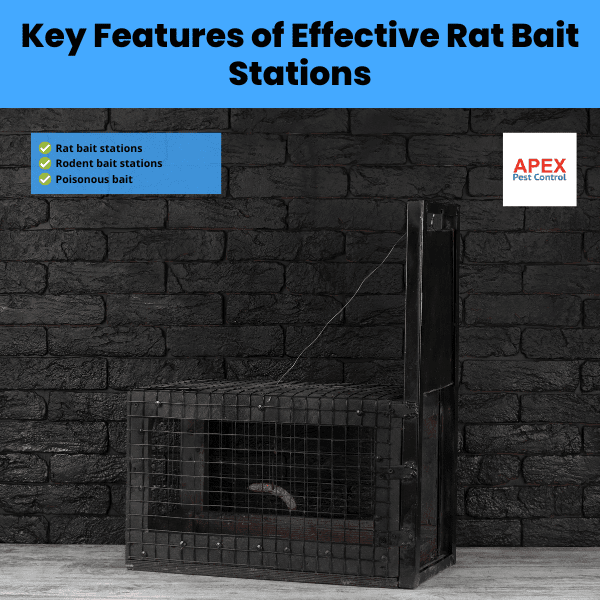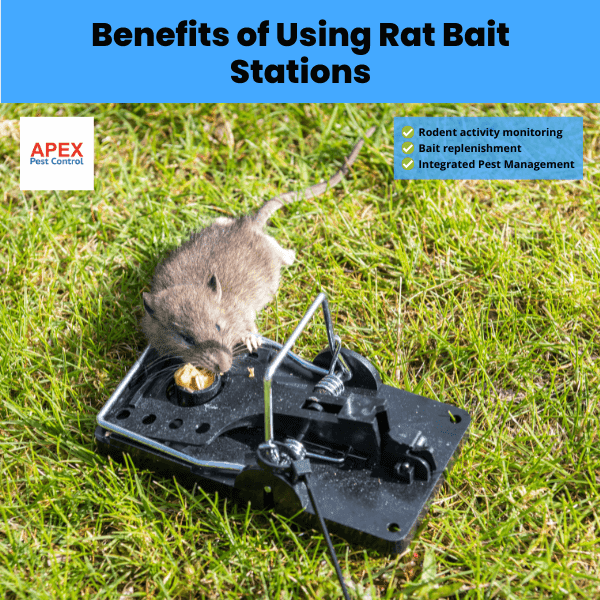Mastering Rat Control: The Essential Guide To Effective Rat Bait Stations
Definition of Rat Bait Stations
A rat bait station, also known as a rodent bait station, is a specific type of device designed to control rat populations in homes or commercial properties. The basic design comprises an enclosed box that houses poisonous bait.
The purpose and function of these stations are twofold: firstly, they offer safe housing for toxic baits used against rats while limiting exposure to other animals or humans; secondly, they serve as an attractive feeding spot for rats due to their confined structure which gives the pests a sense of security.
Explore our detailed guide to Professional Rat Removal, offering trusted methods for safe and effective rat control in your home.
Types of Rodenticides Used in Bait Stations
- Anticoagulant rodenticides (e.g., brodifacoum, bromadiolone)
- Acute toxicants (e.g., bromethalin, cholecalciferol)
- First-generation anticoagulants (e.g., warfarin)
- Second-generation anticoagulants (SGARs)
Types of Rat Bait Stations

Lockable stations come with locks that secure the poison inside and prevent children and non-target animals from accessing it. They typically require keys provided by manufacturers to open them.
Non-lockable stations do not have locks but still contain features like narrow openings to limit access primarily only for small rodents like mice and rats.
Disposable stations come pre-loaded with poison baits meant for one-time use. Once all baits have been consumed or after a certain period passes you dispose off the entire unit without needing to handle any leftover poison directly.
Reusable stations allow repeated refilling once initial lot gets exhausted – thereby offering a long-term solution where persistent rat issues exist.
Innovative Bait Station Designs
Smart IoT Bait Stations
Recent advancements have led to the development of IoT-enabled bait stations that utilise computer vision and sensors to monitor bait levels, rodent activity, and environmental conditions. These smart devices can:
- Capture images for bait estimation and rodent identification
- Monitor temperature and humidity
- Transmit data wirelessly to a central management system
- Optimise bait replenishment schedules
Bait Station Preferences Study
Research has shown that rats have preferences for certain bait station designs:
- Yellow plastic pipe stations
- Wooden box stations (often called ‘rat motels’)
- Wooden tunnel stations
These designs were found to be more attractive to rats compared to white plastic Phil proof bait stations.
Key Features of Effective Rat Bait Stations

Safety measures are primary aspects considered when designing these devices – be it a locking mechanism in some models or unique entry points suited only for rodents ensuring larger pets can’t get in.
Ease-of-use plays a vital role here too – straightforward functionality makes using them less daunting task even if users haven’t encountered such tools before
Durability ensures effective pest management over time – sturdy plastic construction resists weather conditions allowing outdoor use throughout the year maintaining safety & efficacy simultaneously
Size/design influence how attractively station presents itself from rat’s perspective – compact size enables easy concealment while internal maze-like designs increase chances rats explore further into device
Advanced Features in Modern Bait Stations
- Tamper-resistant mechanisms
- Weather-resistant materials for outdoor use
- Bait securing rods to prevent bait removal
- Multiple entry points for increased accessibility
- Clear tops for easy bait level inspection
How To Use Rat Bait Stations

Proper placement is key – setting stations along walls or corners where you have spotted rat activity can increase chances of successful pest management
Choosing the right bait also plays a significant role – several poison baits are available on the market, selecting one that appeals to your specific rodent population may require trial and error.
Regular maintenance/monitoring ensures station stays effective; it involves checking for any leftover bait, replacing it timely & keeping an eye on possible signs of ongoing infestation.
Best Practises for Bait Station Deployment
- Conduct a thorough site assessment before placement
- Use non-toxic monitoring baits to identify hotspots
- Place stations at 15-30 foot intervals along rodent runways
- Ensure bait stations are securely fastened to prevent movement
- Keep detailed records of bait consumption and rodent activity
Benefits of Using Rat Bait Stations

Rat bait stations provide protection against accidental poisoning as they keep the harmful substances out of reach of non-target animals and humans.
They help control rat populations by offering enticing feeding spots filled with toxic baits – serving as a centralised hub focusing rodents’ activities in desired location helping capture them more effectively
By controlling rats, these devices prevent potential property damage that might occur due to unchecked growth of their numbers.
Environmental and Economic Benefits
- Reduced use of broadcast pesticides
- Minimised impact on non-target species
- Lower labour costs for pest management professionals
- Decreased property damage from rodent infestations
Potential Drawbacks Of Rat Bait Stations

While designed for safety, there’s still risk non-target animals might access poisonous content if not positioned carefully leading to unwanted harm
Ineffectiveness is another concern which usually arises when stations aren’t used correctly – incorrect placements or unsuitable baits may lead to less than satisfactory results
Finally cost considerations exist; while individual units aren’t expensive long term usage involving frequent refills could add up costs over time
Challenges in Bait Station Implementation
- Development of bait aversion or neophobia in rodent populations
- Potential for secondary poisoning in predators
- Regulatory restrictions on certain rodenticides
- Need for regular monitoring and maintenance
Alternatives To Rat Bait Stations

If you’re reluctant about using poison-based solution traps offer alternative method capturing pests without involving toxins making them safer around pets/kids
Natural repellents work by deterring rats away rather than killing them providing a non-lethal solution however efficacy varies widely among different types of such products.
Professional pest control services offer comprehensive handling situation but come at higher cost making this option suitable for severe infestations
Integrated Pest Management (IPM) Approach
- Exclusion techniques (sealing entry points)
- Habitat modification (removing food sources and harborage)
- Use of ultrasonic repellent devices
- Implementation of sanitation measures
- Biological control methods (e.g., predator encouragement)
Technological Advancements in Rat Control
Computer Vision in Bait Stations
Recent research has explored the use of computer vision technology in rat bait stations. These advanced systems can:
- Estimate bait levels accurately
- Identify rodent species entering the station
- Detect and record rodent behaviour
- Optimise bait replenishment schedules
IoT Integration for Remote Monitoring
Internet of Things (IoT) technology is being incorporated into modern bait station systems, allowing for:
- Real-time monitoring of bait consumption
- Automated alerts for low bait levels or rodent activity
- Data analytics for trend analysis and predictive maintenance
- Integration with pest management software platforms
Regulatory Considerations and Best Practises

Compliance with Pest Control Regulations
- Adherence to local and national pest control guidelines
- Proper documentation of bait station placement and maintenance
- Use of approved rodenticides and bait station designs
- Implementation of risk mitigation measures
Industry Standards and Certifications
- European Committee for Standardisation (CEN) guidelines
- Confederation of European Pest Management Associations (CEPA) standards
- Certified pest control technician training programmes
Final Thoughts On Rat Bait Stations
We’ve seen what a rat bait station is, its types, key features, how to use them effectively and potential benefits. Equally important are the possible drawbacks of using such devices & alternatives available.
Importance of proper usage cannot be overstated as it directly impacts efficacy any pest control effort
For those considering rat bait stations for their rodent problems it’s vital you choose one based on your specific requirements carefully considering all pros/cons associated with different types. Remember that while these tools can provide significant aid in managing pests, prevention remains the best strategy against rodents.
Frequently Asked Questions
What is a rat bait station?
It’s an enclosed box designed to safely house poisonous baits targeting rats – limiting access from non-target animals or humans.
How does a lockable bait station differ from a non-lockable one?
Lockable stations come with locks requiring special keys for opening ensuring maximum safety whereas non-lockable ones rely on unique entry points suited only for small rodents to limit access
Why should I consider reusable stations over disposable ones?
Reusable stations allow refilling once initial baits get exhausted making them a cost-effective choice in the long run where persistent issues exist.
Can other pets accidentally consume poison from these devices?
While risk exists due to curious nature of pets designs like narrow entries & locking mechanisms largely prevent such incidents if devices are placed thoughtfully away from pet-activity zones.
Can professional pest control services replace the need for rat bait stations completely?
Professional services can handle severe infestations efficiently however they involve higher costs; simple preventive measures like keeping areas clean & using tools like rat bait stations could potentially avoid needing such extensive interventions.
How often should rat bait stations be checked and refilled?
Bait stations should be checked at least weekly during active infestations, and refilled as needed. In areas with high rodent activity, more frequent checks may be necessary.
Are rat bait stations safe to use around children?
While designed to be tamper-resistant, bait stations should always be placed out of reach of children. It’s crucial to educate family members about their presence and potential dangers.
What’s the difference between rat bait stations and rat traps?
Rat bait stations contain poisonous bait and are designed for continuous rodent control, while rat traps are mechanical devices that physically capture or kill rats without the use of poison.
Can rat bait stations be used for mouse control as well?
Many rat bait stations can also be effective for mouse control, but it’s important to choose a station design and bait type appropriate for the target rodent species.
How long does it typically take to see results when using rat bait stations?
Results can vary, but you may start seeing a reduction in rodent activity within 1-2 weeks of consistent bait station use. Complete control may take several weeks, especially for larger infestations.

Tony Johnson, Founder & Lead Technician at Apex Pest Control, is a BPCA and NPTA accredited pest management expert with over 35 years’ hands-on experience. Tony specialises in Integrated Pest Management and ensures all services comply with UK pest legislation, including the Wildlife and Countryside Act 1981 and COSHH Regulations 2002. His commitment to continual learning and adapting to industry best practices means clients receive effective, safe solutions for pests affecting homes and businesses across South Yorkshire. Tony’s dedication to professional standards, ethical treatment methods, and local expertise has made him a trusted partner for pest control and prevention.
-
BPCA & NPTA accredited | CHAS certified
-
Committed to UK pest law compliance & safety
-
Focused on effective, ethical pest management for South Yorkshire


